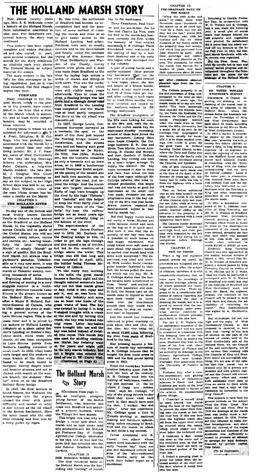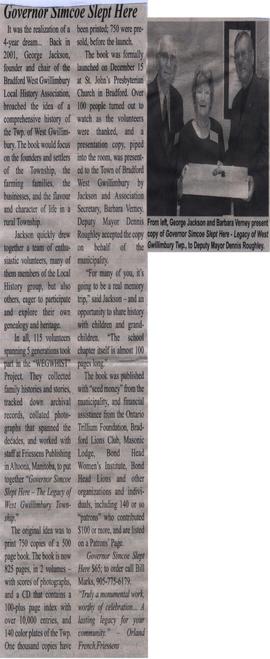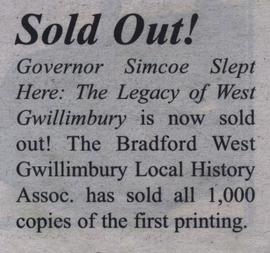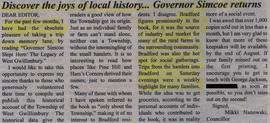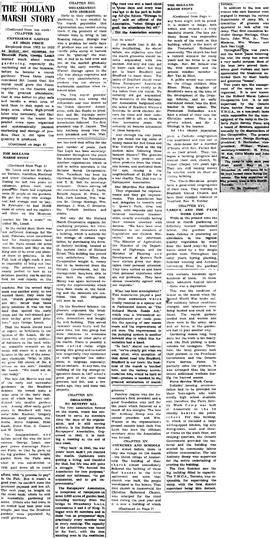The Holland Marsh Story Part Five
- CA BWGPL WEG-Mar-PH25490-PH25494
- Pièce
- 1949
Fait partie de WEGWHIST Collection
Description : The Holland Marsh Story
(Continued from August 31)
Chapter XVII.
Bradford Co-operative Storage Limited
An ambition fostered from the time that the first big marsh harvests were put in storage in city storehouses - the determination to "some day" have a storage of their own right here in Bradford - culminated in a meeting of growers, and the incorporation of the Bradford Co-operative Storage Limited on January 8, 1945. Of course, this co-operative was not the result of one day's work. Much ground work preceded the success of that January meeting, but that was the date on which the terms on which the co-operative would operate were finally agreed upon and application was made for a charter. Provisional directors were named at that time for the new co-operative, namely, George Losak, Gregory Semenuk, J. Lindner, D. Sadovchuk and Wm. Valenteyn.
Stock in the co-operative was sold in shares of $100, and the gardeners themselves purchased $92,000 worth of shares, in other words, subscribed $92,000 toward the erection of the building. There were 150 original shareholders. To-day, there are 148 shareholders. This means that most of the stock made available by changes of residence or other causes, has been quickly purchased by those already holding stock, thus reducing rather than adding to the original number of shareholders.
By the provisions of the Co-operative Marketing Loan Act, the Federal Government gave a grant of 30% and the Provincial Government a loan of 30% toward the cost of construction of the building.
With this financial set-up arranged, work on the building began in 1945, with hopes high that it might be ready for some of the late Fall crop. But shortage of materials and labor problems upset these plans and over a year elapsed before the big building was ready for operation.
Constructed of cement and insulated with cork, the $300,000 Bradford Co-operative Storage is the most modern building of its kind in the province and is second in size among all storages in Ontario; Norfolk Fruit Growers Association Storage being the largest. The capacity of the cooler space here is 428,600 cubic feet.
On August 15, 1946, George C. Carson, manager of the big plant, assumed his new duties. At that time, the directors thought themselves very fortunate in securing Mr. Carson. Today, as they near the third anniversary of his engagement, they know they were fortunate. A native of St. Thomas, Mr. Carson was first employed by the St. Thomas Fruit Growers' Co0operative for four years, three of which he served as manager of their cold storage. Next, he managed the Thedford Cold Storage for four years before enlisting in the Army and serving overseas. After his military discharge, he was with the Agricultural Engineering Department of Ontario Agricultural College until being engaged to come to Bradford. With his wide experience it is not surprising that Mr. Carson has proved to be a most capable manager for the big Bradford Co-operative Storage.
Systematic management has put the big building into year-round use. Fall and Winter months, storage pace is largely given to celery, carrots, beets, potatoes and onions. These vegetables are stored and put on the market according to buyer demands, thus assuring reasonably good prices. When the vegetables were cleared from the storage early last Spring, eggs for Britain were stored, only to be removed for shipment in time to clear space for the early vegetable crops. During July and August, the pre-cooling of lettuce keeps the Co-operative a busy place in the period before the harvesting of the less perishable crops. To give some idea of the use to which this storage building is being used, Mr. Carson informs that in the period May 1, 1947 to May 1, 1948, the storage handled 101,000 packages and from May 1, 1948 to Feb. 28, 1949, 160,000 packages were handled.
Growers, when asked if they were satisfied now that they have a storage of their own, invariably voice bu on criticism - "It isn't big enough".
Chapter XVIII.
Big Business
During the past decade, marsh gardening has truly become big business. Seasons' crops are estimated in the millions, according to the bountifulness of the harvest and the market prices; the value of the crop usually ranging from the $3,500,000 mark to $5,000,000.
Several of the bigger growers have their own storages and others are planning building. Among these gardeners on bigger areas are the Verkaik Bros., whose gardens and building make a beautiful settlement on the West Gwillimbury side of the river. This family is in the growing and marketing business in a big way, packaging and selling under their own brand name. In addition members of the family have dealt in real estate in Bradford and built both residential and business property.
Thornton and Fuller, Bradford, while not gardeners, are big wholesale buyers of marsh produce and own a large amount of storage space for vegetables. In addition to being a member of the wholesale firm, W.H. Thornton owns a crate and box factory, making supplies for marsh produce.
S. Hochreiter has a fine big privately owned storage, located on Highway 11, just south of town. Gerald Rupke and John Maurino & Son are also vegetable storage owners.
Bradford Package Sales Limited, operated by Ed. Tupling, making crates and boxes, is another industry in the town, resulting directly from the marsh development.
As well, there are several wholesale buyers with offices here. We have Bradford Shippers, Bonita Distributors, Ontario Produce Company, Superior Shippers, Federal Distributors, etc. etc. In fact, what used to be "wide open spaces" around the C.N.R. Station and from there along Highway 11 to the bridge, is now built up almost solidly into a hive of industry, all in some way associated with the production on the marsh.
All of this shows the actual gardening is just the beginning of the big business the marsh gardens have created. Small, privately-owned greenhouses are another branch of the gardening here.
And the largest industry of all associated with marsh produce - The Holland River Gardens Co. Limited - has not to date been mentioned.
Chapter XIX.
Holland River Gardens Co. Limited
Holland River Gardens Co. Limited, Bradford, is not only the worlds most modernly equipped vegetable packing plant, built here for the purpose of packing marsh vegetables so as to place them on near and distant markets "garden fresh" but has incorporated int he company a huge marsh garden of more than 300 acres, and all marsh gardeners as members of its board of directors.
The largest headache and heartache for growers in the early years of marsh gardening was marketing. Green vegetables had to be placed on the market green and fresh, with the result that markets had to be close at hand, and products marketed pretty much in season. The big, modern packing plant of Holland River Gardens Co. Limited removed both of these aches for the gardeners.
To furnish the background which resulted in the erection of the fine big plant, one of the Dutch families, which bought marsh land in the Autumn of 1934 and came to the marsh in 1935, should be introduced into our story - the Horlings family. Of this family, three of the brothers, George, Walter and Harry, worked in partnership and by 1942 they were into marsh gardening so extensively that they owned 90 acres of garden land and has secured such a large and steady market for their produce that they found themselves forced into wholesale buying to secure sufficient produce (over and above that grown on their own large acreage) to satisfy their market's demand. It was then that George Horlings left the gardening end of the business to his two brothers and devoted his time to wholesale buying of marsh vegetables. This experience gave him business contacts and extended his vision for the handling of marsh produce. Holland River Gardens Co. Limited is a result of the possibilities realized by those with whom he did business, and by himself.
By Novemeber, 1945, just ten years after the Horlings brothers first came here as gardeners, and three years after George Horlings began wholesale buying of vegetables, Holland River Gardens Co. Limited was organized and incorporated. This organization took place following the most careful study of the vegetable packing business in southern Texas and California, which was surveyed personally y Mr. Horlings and members of the executive. Work was begun almost immediately on the big building and by July 16, 1946, the plant was in operation, with the first washing and "icing" of vegetables for shipment taking place on that day.
The writer of this story recalls that first shipment from the plant very vividly, having been invited to see the first operations. It was just like an assembly line - hampers and crates of vegetables, direct from the gardens, removed from the trucks at the front of the building on Highway 11, carried on roller-bearing tracks past helpers who placed them on trays, on into the washers and then past the packers. Celery and lettuce received the "ice" treatment, being showered with finely-chopped ice before the heavy waxed paper in which they were encased was folded in and crate nailed down - all in one neat operation - then, still on the roller-bearing tracks, on to the waiting trucks at the front of the building, or to the refrigerated cars on the tracks at the rear.
That was the opening day for Holland River Gardens Co. Limited, less than three years ago, and the intervening period has been one of amazing progress. Personnel is always a vital part of a company's success and to-day the executive is the same as it was when the company was organized.
The Executive
Mr. A. Dees, formerly of Dominion Stores, is President of the company. Mr. Dees has had extensive experience in growing and marketing vegetables, both in Europe and in Canada, and in this, in addition to his wide experience and ability in the business world, qualifies him completely for his responsible position.
Mr. George Horlings is Vice-President and General Manager of the company and the success of the past three years has confirmed that the opinion of everyone who knew George Horlings was correct - he is the right man in the right place. First and foremost, he is a marsh gardener and a good one. He is one of that early group of gardeners who worked so persistently and intelligently for the things that have made the marsh what it is today. He is known, respected and trusted by the other growers. As well as being known as a most honest and honourable gentleman, he has the necessary business ability, together with a friendliness of manner, which will win friends for him wherever he goes.
George Horlings has two brothers on the executive of Holland River Gardens Co. Limited - Walter Horlings is Production Manager of the company's big marsh garden farm and Harry Horlings is Farm Personnel Manager on the farm. Both these brothers too, married since coming to the marsh. The former returned to Holland for his wife and the latter married a daughter of the marsh, Miss Van Dyken.
In addition to Mr. Dees and the three Horlings brothers, members of the executive include G.B. Cameron, Ralph Matthews and Victor Turner. Mr. Cameron is the very efficient Secretary-Treasurer for the company. Before coming to the plant, he was Fruit Office Manager for the Dominion Stores. Ralph Matthews, who is a brother-in-law of the Horlings brothers, is Plant Superintendent, and before coming here was foreman with the Kelsey Wheel Company in Windsor. Victor Turner, former highland farmer, marshland grower, reeve of West Gwillimbury in general a widely known and popular gentleman, with a broad experience and knowledge of the marsh, is the company's buyer. Every man of the group is not only well qualified for his business duties, but together they form a most congenial group, working harmoniously and well.
The Plant
Fronting on Highway 11, with the C.N.R. tracks at the rear, and located at the south-eastern end of Bradford overlooking miles of marshland gardens to the south-west, the size of the Holland River Gardens Co. Limited plant was doubled within two years of its commencing operations. To the packing plant proper, last year a cold-storage building was added. This new addition gives a year round service to the plant. With an ice capacity of 200,000 cubic feet (or 4,000 tons), this addition has put the company in the ice business during the Summer months, and not only can it now supply Bradford and surrounding area with all needed ice, but it has its own supply for ice packing, as well as for icing refrigerator cars, thus ensuring quicker delivery to customers. An icing deck has been built for the purpose of bunker icing of railroad cars and on car can be bunker iced in approximately five minutes. The company has made a contract with the railroad for bunker icing all cars loaded in the Bradford area, or for re0icing any cars passing through Bradford which may require this service. With the ice season by, in the Autumn, the building becomes a cold storage, with a capacity for storage of 30,000 to 35,000 crates of celery.
Ice packing and pre-packaging of vegetables are specialties of the plant. Ice packing of celery and lettuce has extended the markets for these Holland Marsh products from Halifax to Vancouver, as well as to many U.S. point, whereas without this treatment these products could only reach local markets. An interesting fact in this regard is that of the produce packed in the plant, 75% of it is shipped to points outside the local market area. As well as ice packing the most perishable type of produce, the plant is fully equipped to wash, grade and pack all other vegetables. Pre-packaging is the packaging of vegetables, especially onions and potatoes, in 5 to 10 pound packages for ht small consumer. The onions are packed in mesh bags. A new departure in the prepackaging was begun last year and is continuing with success - the vegetable salad, packed in cellophane bags. This salad is prepared by machinery, with which the plant is equipped, and is ice packed.
While business for the plant has exceeded expectations to date, the equipment and building are capable of handling a much larger quantity of vegetables than has been packed so far, if only additional markets could be found.
When the plant was opened, the management estimated it would employ about 10 person the year round, taking on extra hands in the rush season. During the past two years some 40 employees have been given year-round employment, with extras engaged during the harvest months. Holland River Gardens Co. Limited employees are protected by group insurance, benefits from which cover employees' families as well as the employees.
The plant has a trackage space for 10 cars. It also owns give trucks, which truck for the plant all year, while during the busy Summer season, when its own truck service is inadequate private truckers are employed.
The fame of Holland Marsh vegetables and Holland River Gardens Co. Limited packing has spread far, as is indicated by distant visitors to the plant. These included not only those from distant parts of the Dominion and United States, but from South Africa and many European countries.
The Farm
Operated as a foundation of supplies to the plant, the company's farm comprises over 300 acres. Of this, 70 acres are on Strawberry Lane and 240 are located to the south-west of that area. In reference to the farm Mr. Walter Horlings, its production manager, stated that the new highway passes through the area, with the clover leaf on the marsh about 2,000 feet away. While this farm is operated to provide a continual supply of vegetables to the plant, it only contributes 15% of the total quantity of vegetables supplied for packing here.
"The Holland Marsh is one of the best, if not the very best, land areas for vegetable growing in Canada," stated a company official. "It holds moisture in dry weather. Just go beneath the surface and the soil is moist, while in a period of heavy rains, the pumps take care of extra water. With proper fertilizing, it grows vegetables unsurpassed both in quality and quantity."
The Holland River Gardens Co. farm is a most modernly mechanized farm. Although as personnel manager, Harry Horlings has around 50 employees, without modern machinery it would not be possible to handle to advantage the big garden area, according to production manager Walter Horlings. As an example of what modern machinery can do on a marsh garden, one type of machine was described. Last Fall, this machine harvested 4,000 bushels of produce in one day. In seven seconds, the machine dug, cut off tops, and filled one hamper with carrots. This type of machine is also used for harvesting onions and beets
The combination of farm and plant operation is very desirable from more than the supply angle. It keep the packing end of the business in sympathetic touch with the growers because the packing plant is also a gardener and, therefore, its main interest is in keeping prices firm.
The Future
And what of the future of the Holland River Gardens Co. Limited plant? It has doubled in size in less than three years. It is equipped to handle a very much greater quantity of vegetables as garden production increases. Its products have established a most enviable reputation the breadth of this continent. It is continually experimenting, and branching into new fields, of which prepackaging is the result. It is surely safe to predict that it will experience a tremendous expansion as marsh production provides the produce for its growth.
What does this plant do for the grower? It has broadened markets by thousands of miles and it has advertised the quality of Holland Marsh vegetables over the same extensive territory by putting them on distant markets as fresh and crisp as when taken from the gardens.
What has the plant and the marsh done for Bradford? Well, if you don't know, just recall the population here in 1936. Recall property values, wages paid and business transacted prior to the date, and give credit where credit is due. Yes, the Holland Marsh gardens and all of the industries which have developed from them, right up to the biggest of all, Holland River Gardens Co. Limited, have made a contribution to the prosperity of every resident of this town.
Chapter XX.
Additional Business Resulting From Marsh
And now the story of the Holland Marsh is nearly up to date, but it would be incomplete without reference to business directly, and indirectly, resulting from the marsh gardens.
New businesses have been opened in Bradford because of the opportunity of doing business in new lines with the gardeners. One of these is the Bradford Seed House.
Bradford Seed House
Like most of the business enterprises connected with the Holland Marsh, Bradford Seed House, which is operated by Mr. Harvey W. Curry, started in a small way.
In 1941, Mr. Fred. Edwards, who, for several years, had been engaged in selling a line of seeds, fertilizers, containers, etc., to the growers, decided to move out of Bradford, but, before leaving, asked Mr. Curry if he would take over the selling of celery crates for the manufacturer who was located near Perry Sound. During this season and the next, 1942, Mr. Curry operated without a place of business other than his home - his car was his office.
However, in the pursuit of his business, he was asked by the growers if he sold various items other than crates. The demand became so great that he decided to add these extra lines. It now became necessary to have a definite place of business. So, in the Fall of 1942, he began to renovate his present location and by the following March was able to move in.
Since that time he has added many lines of merchandise peculiar to gardening and farming, and, besides serving the Holland Marsh with seeds, vegetable containers, spraying and dusting equipment, etc., both he and his assistant are kept busy supplying the townsfolk and local farmers with seed, nursery stock, flowers - on-occasion, or whatever they might need to improve the appearance of their homes.
Thornton and Fuller
A big firm which began, has developed, and is continuing in growth here as a direct result of the marsh is the Thornton and Fuller firm, which handles wholesale produce, fertilizers, bags, hampers and crates, etc.
The firm of Thornton and Fuller means W. H. Thornton and William Fuller. Beginning in a comparatively small way as crate makers and produce buyers, the firm has grown tremendously. The business office is still the home of W. H. Thornton and a certain amount of storage space is at the rear of that property. In addition to all this, their crate-making factory is located to the south of Bradford, on land adjoining the marsh, and on the marsh they have a large cold storage.
Thornton and Fuller have marsh gardens. They employ some 30 persons and operate eight trucks. It's a big business.
Makes Business For All
In addition to businesses already mentioned in Holland Marsh articles, directly or indirectly growing from our marsh gardens, we the Bradford Crate and Box Company, operated by Mr. E. Tupling and Mr. Russell. This firm's building and property is what was formerly the main building on the old Fair Grounds.
But new businesses associated with the marsh gardens are not the only businesses affected by the gardens. Every business in Bradford has been made much more prosperous by the marsh people who shop here. The business section of this town is greatly improved and enlarged as the result of marsh development.
And while we lack verification for this, the Townships involved must also benefit, because the land which 20 years ago grew marsh hay is today valued per acre many times over the prices being paid for the best high land, all of which must have a beneficial effect on taxation.
Tribute
In completing this record of the Holland Marsh, to date, tribute should be paid to the members of Council of the initiating municipality of West Gwillimbury, whose foresight and determination carried through the big Drainage Scheme project, namely, Reeve J. F. Hambly, Councillors Louis Neilly, Percy Selby, W. J. Dales and the late Herman Lennox, and every other one of those men who worked for the scheme; to everyone of the pioneer gardeners, and to all who laid the foundations on which the gardens and industry and business resulting from them, have been built.
Chapter XXI.
Big Business for C.N.R.
Elwood James, Inspector of Vegetables, supplied the editors with a record of the shipment of vegetables from Bradford, via C.N.R., by the carload during the past three years.
In the April 1946 to April, 1947, period, 992 cars of vegetables were shipped from here via Canadian National Railways; in the April 1947 to April, 1948m period, there were 824 carloads; and in the April, 1948 to March 31, 1949, period, the shipment from Bradford was 1,036 carloads of vegetables.
During the past year, the shipments were made up as follows:
Onions, 441; carrots, 51; celery, 171; lettuce, 55; mixed cars, 214; beets, 17; potatoes, 1; L.C.L. shipments, 54; express cars, 29. Total, 1,036 carloads.
Chapter XXII.
The Marsh People
Let us introduce you to some of the marsh residents. There are the Atamachuks, Biemolds, Boonstras, Baks, Bartkos, Bereznicks, Bernyks, Bodnarchuiks, Brinkos, Brouwers, Catanias, Caesars, Chyzs, Csehs, Decyks, De Jongs, Dragons, Dugas, Dutkos, Gajdos, Gatti, Gres, Horlings, Hucks, Hutftusz, Hlmas, Hazsudas, Harvillas, Hochreiters, Havingas, Hurd, Jaques, Kacmars, Kapisaks, Kauchaks, Kiss, Knipfs, Kanyos, Kolariks, Kulhas, Lindners, Lohnes, Losaks, Lottos, Matthews, Miedemas, Moritz, Magetiaks, Maurinos, Megani, Misatas, Malkos, Megalos, Molokachs, Melenicks, Melynchuks, Mestdaghs, Morganthalers, Nuzdas, Nydams, Oosterhuis, Osadchuks, Parrys, Peters, Prins, Petryks, Podobas, Pikulas, Plackos, Phillips, Podabas, Propkochuks, Prymas, Rols, Rupkes, Rajcas, Sauners, Simones, Sneeps, Spezialis, Sadovchaks, Simurdas, Sklencars, Sopuchs, Sakaliks, Sadlons, Siervogels, Semenuks, Soderbergs, Skabernickys, Smiths, Socolowskys, Toorenaars, Takatas, Taylors, Turkstras, Uitvlugts, Van Dykes, Van Dykens, Van der Kleyns, Van Dykes, Vander Meers, Valenteyns, Van Hofs, Vernons, Valentinuzzis, Vargas, Vdovjaks, Velebirs, Verkaiks, Vrabliks, Vandergoots, Verrips, Watsons, Winters, Wists, Wouters, Winterkorns, Wrabkos, Webers, Wolfes, Yoshimuras, Ziemianskis, Zuraskis, Zucchettis, and several hundred other families.
Whether it is because of the word "Holland" in Holland Marsh, or because of the Dutch Settlement, which is the marsh's only village or whatever the reason may be, other parts of this province appear to have gained the impression that nearly all of the marsh residents are of Dutch origin. Give your address as Bradford to most strangers and almost invariably the answer is : "Oh yes, Bradford, you have a lot of Hollander sup there on the marsh."
Well, we have a great many marsh residents who are either natives of Holland or of Dutch origin, but the marsh population is certainly not essentially Dutch. There are many Hollanders, and finer people cannot be found the breadth of this Dominion, but the marsh population boasts immigrants, and children of immigrants, from practically every European country, as well as parts of Asia. They or their ancestors, were born in Italy, Germany, Czecho-Slovakia, Yugo-Slavia, Rumania, Poland or the Far East - Japan or China - as well as in Britain. Most of them belong to divided families, with many of their relatives still in the motherland countries at war with one another and with Canada, and during those years of war, marsh men lived at peace with their neighbours.
Why could a man from Holland, with brothers and sisters in the territory over-run by German troops, live in friendship with his neighbour who hailed from Germany and, ten chances to one, had relatives in the said German army? And so, on down the line, the motherlands warred while the sons and daughters on the marsh tilled the soil and lived at peace with one another.
There are several contributing factors to the unity of marsh people, the first and foremost being that they are all Canadians and Canada has been good to them. Many of them have paid visits to their native lands since the war and without exception, they have told us upon returning that they are glad to be "home". "There is so much more freedom here than over there," they say. They worked together in the years of adversity - the depression years before the war - and they shared the worries and hardships of those years, each respecting the other for his courage in facing adversity. They worked together happily when times were bad, so why shouldn't that friendship continue during more prosperous days regardless of what political leaders in their motherlands do to one another. If the political leaders of our countries became as tolerant, as understanding, and as generous with their neighbours as our marsh men are with one another, wars would cease and peace and prosperity would be the way of the world.
Yet, while the racial back ground of our Canadian marsh residents does not affect their neighbourliness and friendship, is it noticeable that the closest bonds are among their own people. The Holland Canadians marry almost always among themselves; the Czecho-Slovaks the same, as do the descendants of practically all other races, including those of British descent.
They are law-abiding people. There is not a juvenile delinquency problem on the marsh - the sons and daughters are too busy to be "problem" children. Parents, as well as children, are anxious that the boys and girls receive full benefit of the opportunities opened here and as a result, children from the marsh are usually highly-rated students in High School and at University, several being University graduates. Their homes, their church, their families, and the financial progress which will benefit these three are the chief interest of the average marsh man's life. All in all, they are the very best type of citizen. They are glad to be Canadians and Canada has reason to be glad that such fine people chose Canada as their home.
Social life on the marsh in the early days was confined pretty much to church friendships; business meetings amongst the men, and the big annual banquet in Bradford in the Fall. The marsh population grew, its members so exceeded catering facilities in Bradford that the annual banquet was dropped.
THE END.
Sans titre


